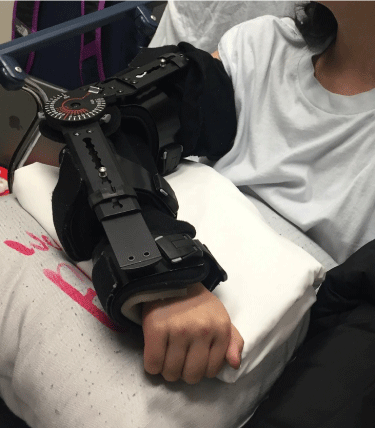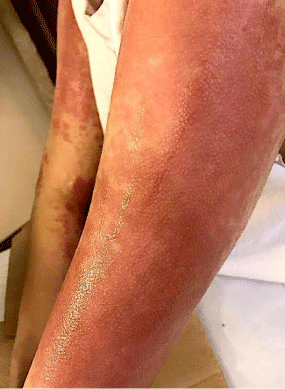Abstract
Stevens-Johnson syndrome (SJS) and Toxic Epidermal Necrolysis (TEN) form a spectrum of severe mucocutaneous reactions, characterized by epidermal detachment and necrosis. Though disease mortality and morbidity are high, treatment remains mostly of supportive measures with varying efficacy. Here we present the case of a patient with SJS/TEN overlap as well as ongoing external cast compression for her forearm. While the rest of her body showed extensive skin involvement, the casted arm region had reduced skin severity and progression throughout the rest of the disease course. Although cast compression has been previously used in burn patients, this case report examining cast compression in a patient with SJS/TEN may offer insight into an adjunctive supportive treatment for this highly morbid disease.
Keywords: Stevens-johnsons syndrome; Toxic epidermal necrolysis; External compression; Case report
Case Presentation
A 22-year-old woman with recent Monteggia fracture complicated by osteomyelitis following multiple open reduction internal fixation and debridement operations presented with a three-day duration of fevers and bilateral cheek redness. Seven days prior to presentation, she was started on trimethoprim-sulfamethoxazole for ongoing osteomyelitis. At presentation, she denied dyspnea, chest pain, diarrhea, abdominal pain, and nausea or vomiting. Vital signs were remarkable for fever of 102 degrees Fahrenheit. Her cheeks exhibited pink well-demarcated patches without nasolabial fold sparing or pruritus. Labs were significant for white blood cell count of 15, and hemoglobin of 10. Within the next few hours, her rash spread from her cheeks downwards to her entire back, central chest, abdomen, and lower legs.
The antibiotic was discontinued immediately upon hospital admission. A diagnosis of Stevens-Johnsons Syndrome /Toxic- Epidermal-Necrolysis (SJS/TEN) overlap was made, given total body surface area of approximately 25% affected and multiple blistering and denuded sites present throughout her upper arms, trunk, and back (Figure 1). Her course was complicated by right corneal damage requiring amniotic membrane placement. Due to her recent arm operation, her right forearm was enclosed in a short metal cast from her elbow to hand sparing the fingers (Figure 2). Interestingly, the skin underneath the casted area remained well-demarcated and less affected from erythema or sloughing, despite extensive involvement elsewhere; and this lack of progression in this area continued throughout the rest of the disease course (Figures 3 and 4).

Figure 1: SJS/TEN overlap involving the patient’s back.

Figure 2: Right arm external cast compression device.

Figure 3: Erythema and sloughing spared the areas affected by external
compression.

Figure 4: In comparison to the right arm, the left arm exhibited dusky
erythema throughout.
Discussion
SJS/TEN form a spectrum of life-threatening hypersensitivity reactions characterized by necrosis of mucocutaneous surfaces, often associated with sepsis, dehydration, and multi-organ failure [1]. They represent true medical emergencies, and early recognition and management is crucial for overall patient survival. SJS is defined as skin involvement of <10%, while TEN represents skin involvement >30%; as a result, SJS/TEN overlap covers 10-30% skin involvement [2]. Common inducing medications include antiepileptics, sulfonamides, allopurinol, and nevirapine. Despite being dermatological emergencies, treatment remains mostly supportive. Multiple studies have proposed corticosteroids, cyclosporine, and Intravenous Immunoglobulin (IVIG) use with varying evidence for improved outcomes and reduced mortality rates [3].
Our case describes a unique presentation of SJS/TEN overlap with concurrent external cast compression showing well-demarcated skin sparing from SJS/TEN. To our knowledge, there are no studies on the potential utility of external compression for minimizing SJS severity. There is evidence, however, that compression may be a helpful treatment approach for burn patients. One retrospective review on the therapeutic effects of Negative Pressure Wound Therapy (NPWT) for children suggested a significant correlation between third-degree burn size and number of NPWT treatments received [4]. Multiple articles have also examined the qualitative experience of compression garments after burns suggesting shorter healing times and symptom relief [5]. Another study regarding role of early pressure garment application following burns showed increased expression of matrix metalloproteinase-1 in the immediate versus delayed pressure garment group, with associated reduced postburn scarring [6]. While this research has been conducted on burn patients, the results can also be applicable to SJS/TEN patients given similar rapid skin necrosis.
Conclusion
Although precise reasons for this presentation are unclear, we are hopeful that this report can initiate discussion regarding novel use of compression as a non-costly, non-invasive means to reduce SJS/TEN spread. Its benefits on burn patients have already been previously described, and the unusual circumstances that preclude this case presentation are so fortuitous as to highlight external compression as a potential adjunctive therapy in similarly affected patients, i.e. those with SJS/TEN. Given the preventative quality of this therapy, it is worthwhile to consider trialing for prospective SJS patients in minimizing disease severity and spread.
References
- Micheletti RG, Chiesa-Fuxench Z, Noe MH. Stevens-Johnson Syndrome/ Toxic Epidermal Necrolysis: A multicenter retrospective study of 377 adult patients from the United States. J Invest Dermatol. 2018; 138: 2315-2321.
- Lerch M, Mainetti C, terziroli Beretat-Piccoli B, Harr T. Current perspectives on Stevens-Johnson Syndrome and Toxic Epidermal Necrolysis. Clin Rev Allergy Immunol. 2018; 54: 147-176.
- Kumar R, Das A, Das S. Management of Stevens-Johnson Syndrome-Toxic Epidermal Necrolysis: Looking beyond guidelines. Indian J Dermatol. 2018; 63: 117-124.
- Ren Y, Chang P, Sheridan RL. Negative wound pressure therapy is safe and useful in pediatric burn patients. Int J Burns Trauma. 2017; 7: 12-16.
- Coghlan N, Copley J, Aplin T. Patient experience of wearing compression garments post burn injury: A review of the literature. J Burn Care and Research. 2017; 38: 260-269.
- DeBruler DM, Baumann ME, Blackstone BN. Role of early application of pressure garments following burn injury and autografting. Plast Reconstr Surg. 2019; 143: 310-321.
